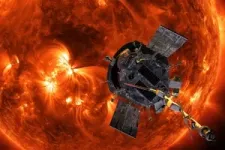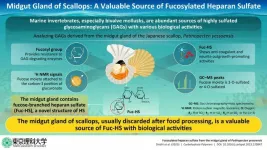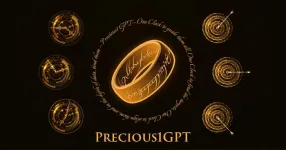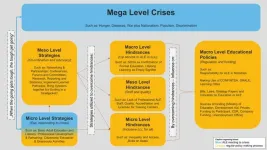(Press-News.org) The Geminids meteoroids light up the sky as they race past Earth each winter, producing one of the most intense meteor showers in our night sky.
Mysteries surrounding the origin of this meteoroid stream have long fascinated scientists because, while most meteor showers are created when a comet emits a tail of ice and dust, the Geminids stem from an asteroid — a chunk of rock that normally does not produce a tail. Until recently, the Geminids had only been studied from Earth.
Now, Princeton researchers used observations from NASA’s Parker Solar Probe mission to deduce that it was likely a violent, catastrophic event — such as a high-speed collision with another body or a gaseous explosion — that created the Geminids. The findings, which were published in the Planetary Science Journal on June 15, narrow down hypotheses about this asteroid’s composition and history that would explain its unconventional behavior.
“Asteroids are like little time capsules for the formation of our solar system,” said Jamey Szalay, research scholar at the Princeton University space physics laboratory and co-author on the paper. “They were formed when our solar system was formed, and understanding their composition gives us another piece of the story.”
An unusual asteroid
Unlike most known meteor showers that come from comets, which are made of ice and dust, the Geminids stream seems to originate from an asteroid — a chunk of rock and metal — called 3200 Phaethon.
“Most meteoroid streams are formed via a cometary mechanism, it’s unusual that this one seems to be from an asteroid,” said Wolf Cukier, undergraduate class of 2024 at Princeton and lead author on the paper.
“Additionally, the stream is orbiting slightly outside of its parent body when it’s closest to the sun, which isn’t obvious to explain just by looking at it,” he added, referring to a recent study with Parker Solar Probe images of the Geminids led by Karl Battams of the Naval Research Laboratory.
When a comet travels close to the Sun it gets hotter, causing the ice on the surface to release a tail of gas, which in turn drags with it little pieces of ice and dust. This material continues to trail behind the comet as it stays within the Sun’s gravitational pull. Over time, this repeated process fills the orbit of the parent body with material to form a meteoroid stream.
But because asteroids like 3200 Phaethon are made of rock and metal, they are not typically affected by the Sun’s heat the way comets are, leaving scientists to wonder what causes the formation of 3200 Phaethon’s stream across the night sky.
“What’s really weird is that we know that 3200 Phaethon is an asteroid, but as it flies by the Sun, it seems to have some kind of temperature-driven activity,” Szalay said. “Most asteroids don’t do that.”
Some researchers have suggested that 3200 Phaethon may actually be a comet that lost all of its snow, leaving only a rocky core resembling an asteroid. But the new Parker Solar Probe data show that although some of 3200 Phaethon’s activity is related to temperature, the creation of the Geminids stream was likely not caused by a cometary mechanism, but by something much more catastrophic.
Opening the time capsule
To learn about the origin of the Geminids stream, Cukier and Szalay used the new Parker Solar Probe data to model three possible formation scenarios, then compared these models to existing models created from Earth-based observations.
“There are what’s called the ‘basic’ model of formation of a meteoroid stream, and the ‘violent’ creation model,” Cukier said. “It’s called ‘basic’ because it’s the most straight-forward thing to model, but really these processes are both violent, just different degrees of violence.”
These different models reflect the chain of events that would transpire according to the laws of physics based on different scenarios. For example, Cukier used the basic model to simulate all of the chunks of material releasing from the asteroid with zero relative velocity — or with no speed or direction relative to 3200 Phaethon — to see what the resulting orbit would look like and compare it to the orbit shown by the Parker Solar Probe probe data.
He then used the violent creation model to simulate the material releasing from the asteroid with a relative velocity of up to one kilometer per hour, as if the pieces were knocked loose by a sudden, violent event.
He also simulated the cometary model — the mechanism behind the formation of most meteoroid streams. The resulting simulated orbit matched the least with the way the Geminids orbit actually appears according to the Parker Solar Probe data, so they ruled out this scenario.
In comparing the simulated orbits from each of the models, the team found that the violent models were most consistent with the Parker Solar Probe data, meaning it’s likely that a sudden, violent event — such as a high-speed collision with another body or a gaseous explosion, among other possibilities — created the Geminids stream.
The research builds on the work of Szalay and several colleagues of the Parker Solar Probe mission, built and assembled at the Johns Hopkins Applied Physics Laboratory (APL) in Laurel, Maryland, to assemble a picture of the structure and behavior of the large cloud of dust that swirls through the innermost solar system.
They took advantage of Parker’s flight path — an orbit that swings it just millions of miles from the Sun, closer than any spacecraft in history — to get the best direct look at the dusty cloud of grains shed from passing comets and asteroids.
Although the probe doesn’t measure dust particles directly, it can track dust grains in a clever way: as dust grains pelt the spacecraft along its path, the high-velocity impacts create plasma clouds. These impact clouds produce unique signals in electric potential that are picked up by several sensors on the probe's FIELDS instrument, which is designed to measure the electric and magnetic fields near the Sun.
“The first-of-its-kind data our spacecraft is gathering now will be analyzed for decades to come,” said Nour Raouafi, Parker Solar Probe project scientist at APL. “And it’s exciting to see scientists of all levels and skills digging into it to shed light on the Sun, the solar system and the universe beyond.”
Reaching for the stars
Cukier said his passion for learning about outer space combined with departmental support are what motivated him to pursue this project.
After taking a hands-on lab class offered by the Princeton space physics laboratory — where he gained practical experience building space instruments, like those currently sampling the Sun’s environment aboard Parker Solar Probe — and serving as treasurer for the undergraduate astronomy club, he decided he wanted to pursue extracurricular research.
He was met with enthusiasm when he reached out to scientists in the Princeton Space Physics group. “Everyone is very supportive of undergraduate research, especially in astrophysics, because it’s really part of the departmental culture,” he said.
“It’s always wonderful when our students like Wolf can contribute so strongly to this sort of space research,” said David McComas, head of the Space Physics group and vice president for the Princeton Plasma Physics Laboratory (PPPL). “Many of us have been in awe of the Geminids meteor displays for years and it is awesome to finally have the data and research to show how they likely formed.”
Cukier said that he’s been drawn to watching the sky since he was a kid. “Planetary science is surprisingly accessible,” he said. “For the Geminids, for instance, anyone can go outside on December 14 this year at night and look up. It’s visible from Princeton, and some of the meteors are really bright. I’d highly recommend seeing it.”
“Formation, Structure, and Detectability of the Geminids Meteoroid Stream” by W.Z. Cukier and J.R. Szalay was published June 15, 2023 by Planetary Science Journal (DOI 10.3847/PSJ/acd538). The research was supported by the Parker Solar Probe Guest Investigator Program (80NSSC21K1764). Parker Solar Probe is part of NASA's Living with a Star program to explore aspects of the Sun-Earth system that directly affect life and society. The program is managed by NASA's Goddard Space Flight Center for the Heliophysics Division of NASA's Science Mission Directorate. APL manages the Parker Solar Probe mission for NASA.
END
Researchers demystify the unusual origin of the Geminids meteor shower
Princeton researchers used data from NASA's Parker Solar Probe to deduce that a catastrophic event likely created the prolific Geminids meteoroid stream.
2023-06-15
ELSE PRESS RELEASES FROM THIS DATE:
Historic redlining practices cast a long shadow on cancer screening rates
2023-06-15
Key Takeaways
Banned since 1968, the legacy of redlining persists: There continue to be instances of discrimination affecting people in these historically redlined areas.
Redlining was associated with lower odds of hitting screening targets for all three types of cancer: 24% lower odds in breast cancer, 64% lower odds in colorectal, and 79% lower odds in cervical cancer, compared with non-redlined areas.
Actionable initiatives to improve cancer screening rates: Questionnaires to determine barriers to cancer screening, mobile cancer screening ...
Midgut gland of scallops: a valuable source of fucosylated heparan sulfate
2023-06-15
Glycosaminoglycans (GAGs), including chondroitin sulfate (CS), heparan sulfate (HS), heparin, and hyaluronan are linear and acidic polysaccharides found in the extracellular matrix of all animal tissues. GAGs are widely used as functional ingredients in health products, pharmaceuticals, and cosmetics, and are prepared from biological samples such as shark cartilage and porcine intestinal mucosa. Consequently, the demand for new sources of GAGs is ever-present. For example, the supply source of the anticoagulant heparin—generally prepared from porcine intestinal mucosa in China—was threatened by African swine fever in 2018.
GAGs derived from marine invertebrates—animals ...
University of Cincinnati research finds potential therapy for rare but devastating lung disease
2023-06-15
A treatment for a rare cancer-like lung disease found in women of childbearing age may have been discovered by University of Cincinnati researchers.
The rare lung disease is called lymphangioleiomyomatosis or LAM, and the cause of it is unknown with no cure established. New UC research, funded by the National Heart, Lung, and Blood Institute, discovered that two existing drugs show signs of being effective in treating LAM and could lead to the development of a cure.
The study was published in Science Advances,
“The exact number of women with LAM is unknown but it is estimated that for every 1 million women in the world, three to seven ...
Insilico Medicine’s transformer-based aging clock provides insights into aging, disease, and new therapeutic targets
2023-06-15
Clinical stage generative artificial intelligence (AI)-driven drug discovery company Insilico Medicine (“Insilico”) has announced a new multimodal transformer-based aging clock that is capable of processing diverse data sets and providing insights into biomarkers for aging, mapping them to genes relevant to both aging and disease, and discovering new therapeutic targets designed to slow or reverse both aging and aging-related diseases. The company calls the aging clock Precious1GPT, in a nod to the powerful “One Ring” in Lord of the Rings. The findings were published in the June 13 issue of the journal Aging.
Insilico has been ...
Hip fracture burden to nearly double worldwide by 2050
2023-06-15
An international group of researchers led by the Department of Pharmacology and Pharmacy, LKS Faculty of Medicine, the University of Hong Kong (HKUMed), and including Douglas P Kiel, MD, MPH, Director Musculoskeletal Research Center, Marcus Institute for Aging Research, Hebrew SeniorLife, and Professor of Medicine, Harvard Medical School, evaluated the secular trends in hip fracture incidence, treatment patterns following a hip fracture, and all-cause mortality in 19 countries and regions from 2005 to 2018. While the age- and sex-standardised hip fracture incidence rates decreased ...
Research findings „Study on Adult Learning and Education“
2023-06-15
From August 2022 until October 2022, interviews with 25 experts from the selected countries were conducted and then analyzed trough a Ground Theory approach. From this, a model emerged, showing how factors and actors at different societal levels - mega, macro, meso and micro - interact to shape adult learning and education in different contexts.
Mega level comparisons show that overarching issues such as war and conflict, historical and systemic discrimination, disease and extreme poverty as well as political authoritarianism act both as an impetus and as barriers to ALE activities.
Comparative analysis shows that at the macro level, with ...
New tool uncovers COVID-19 susceptibility mechanism
2023-06-15
Researchers have discovered a mechanism for COVID-19 susceptibility using a newly created tool. The tool, GASPACHO, captures dynamic changes in gene expression along the innate immune response, allowing researchers to identify genes and molecular pathways associated with disease risk that have previously been too complex to detect or interpret.
Using GASPACHO (GAuSsian Processes for Association mapping leveraging Cell HeterOgeneity), researchers at the Wellcome Sanger Institute, the National Center for Child Health and Development in Japan, Tel Aviv University and their collaborators have identified a gene variant that affects COVID-19 susceptibility. ...
Jefferson Lab oversight roles filled by DOE
2023-06-15
NEWPORT NEWS, VA – The U.S. Department of Energy has selected Craig Ferguson to lead the Thomas Jefferson Site Office (TJSO) at the Thomas Jefferson National Accelerator Facility in Newport News, Va. As TJSO manager, Ferguson will lead in the oversight and contract management of Jefferson Lab. Additionally, Donté Davis has been confirmed as TJSO deputy manager, a role he first stepped into earlier this year.
Ferguson is familiar with Jefferson Lab and its mission, having already served in a leadership role at the lab. In 2005-2008, he was the lab’s associate director for environment, safety, health & quality.
“I am excited to return ...
High-quality child care contributes to later success in science, math
2023-06-15
Children who receive high-quality child care as babies, toddlers and preschoolers do better in science, technology, engineering and math through high school, and that link is stronger among children from low-income backgrounds, according to research published by the American Psychological Association.
“Our results suggest that caregiving quality in early childhood can build a strong foundation for a trajectory of STEM success,” said study author Andres S. Bustamante, PhD, of the University of California Irvine. “Investing in quality child care and early childhood education could help ...
Study finds that a small number of teachers effectively double the racial gaps among students referred for disciplinary action
2023-06-15
Washington, June 15, 2023—The top 5 percent of teachers most likely to refer students to the principal’s office for disciplinary action do so at such an outsized rate that they effectively double the racial gaps in such referrals, according to new research released today. These gaps are mainly driven by higher numbers of office discipline referrals (ODRs) issued for Black and Hispanic students, compared to White students. The study, published in Educational Researcher, a peer-reviewed journal of the American Educational Research ...
LAST 30 PRESS RELEASES:
Sleeping in on weekends may help boost teens’ mental health
Study: Teens use cellphones for an hour a day at school
After more than two years of war, Palestinian children are hungry, denied education and “like the living dead”
The untold story of life with Prader-Willi syndrome - according to the siblings who live it
How the parasite that ‘gave up sex’ found more hosts – and why its victory won’t last
When is it time to jump? The boiling frog problem of AI use in physics education
Twitter data reveals partisan divide in understanding why pollen season's getting worse
AI is quick but risky for updating old software
Revolutionizing biosecurity: new multi-omics framework to transform invasive species management
From ancient herb to modern medicine: new review unveils the multi-targeted healing potential of Borago officinalis
Building a global scientific community: Biological Diversity Journal announces dual recruitment of Editorial Board and Youth Editorial Board members
Microbes that break down antibiotics help protect ecosystems under drug pollution
Smart biochar that remembers pollutants offers a new way to clean water and recycle biomass
Rice genes matter more than domestication in shaping plant microbiomes
Ticking time bomb: Some farmers report as many as 70 tick encounters over a 6-month period
Turning garden and crop waste into plastics
Scientists discover ‘platypus galaxies’ in the early universe
Seeing thyroid cancer in a new light: when AI meets label-free imaging in the operating room
Neutrophil-to-lymphocyte ratio may aid risk stratification in depressive disorder
2026 Seismological Society of America Annual Meeting
AI-powered ECG analysis offers promising path for early detection of chronic obstructive pulmonary disease, says Mount Sinai researchers
GIMM uncovers flaws in lab-grown heart cells and paves the way for improved treatments
Cracking the evolutionary code of sleep
Medications could help the aging brain cope with surgery, memory impairment
Back pain linked to worse sleep years later in men over 65, according to study
CDC urges ‘shared decision-making’ on some childhood vaccines; many unclear about what that means
New research finds that an ‘equal treatment’ approach to economic opportunity advertising can backfire
Researchers create shape-shifting, self-navigating microparticles
Science army mobilizes to map US soil microbiome
Researchers develop new tools to turn grain crops into biosensors
[Press-News.org] Researchers demystify the unusual origin of the Geminids meteor showerPrinceton researchers used data from NASA's Parker Solar Probe to deduce that a catastrophic event likely created the prolific Geminids meteoroid stream.







